
Introduction
Selecting the appropriate render for your external walls is a crucial decision that can significantly impact the appearance, durability, and performance of your building. With numerous rendering options available, it’s essential to consider various factors to ensure you choose the right render for your specific needs. In this comprehensive guide, we’ll explore the key factors to consider when selecting render for your external walls.
Understanding Different Types of Render
Before delving into the factors to consider, it’s essential to understand the different types of render systems available in the market. From traditional sand and cement render to modern acrylic and silicone render, each type offers unique characteristics and benefits. Consider factors such as texture, finish, colour, and application method when evaluating render options for your external walls.

Factors to Consider When Choosing Render for Your External Walls
- Climate and Environmental Conditions:
The climate and environmental conditions in your area play a significant role in determining the most suitable render for your external walls. For example, if you live in a coastal area with high humidity and salt exposure, you’ll need a render with excellent water resistance and durability to withstand these harsh conditions. - Substrate Type and Condition:
The type and condition of the substrate (i.e., the surface to which the render will be applied) influence the choice of render. Different substrates, such as brick, block, concrete, and timber, require specific rendering techniques and materials. Additionally, the condition of the substrate, including cracks, dampness, and surface irregularities, may affect the selection of render and preparation requirements. - Desired Aesthetic and Finish:
Consider the desired aesthetic and finish you want to achieve for your external walls. Do you prefer a smooth, sleek appearance, or a textured, rustic finish? Different render types offer various textures, finishes, and colors to suit different architectural styles and design preferences. Choose a render that complements the overall look and feel of your property. - Maintenance and Long-Term Durability:
Evaluate the maintenance requirements and long-term durability of the render options under consideration. Some renders may require regular maintenance, such as cleaning and repainting, to maintain their appearance and performance over time. Others, such as acrylic and silicone render, offer excellent durability and color retention with minimal maintenance. - Thermal Performance and Insulation:
Consider the thermal performance and insulation properties of the render, especially if energy efficiency is a priority. Some rendering materials contain insulating additives that help regulate indoor temperatures and reduce heat loss, leading to improved energy efficiency and comfort in your home. - Budget and Cost Considerations:
Finally, consider your budget and cost considerations when choosing render for your external walls. Different render types vary in price, with traditional renders typically being more affordable than premium options like acrylic and silicone render. Factor in not only the initial material and installation costs but also long-term maintenance and durability benefits when making your decision.
Conclusion
Choosing the right render system for your external walls requires careful consideration of various factors, including climate conditions, substrate type, desired aesthetic, maintenance requirements, thermal performance, and budget considerations. By evaluating these factors and understanding the different types of render available, you can make an informed decision that enhances the appearance, durability, and performance of your building. Whether you opt for a traditional sand and cement render or a modern acrylic and silicone render, selecting the right render is essential for achieving optimal results and ensuring the long-term beauty and integrity of your external walls.




